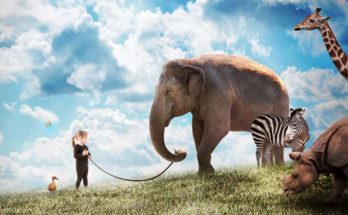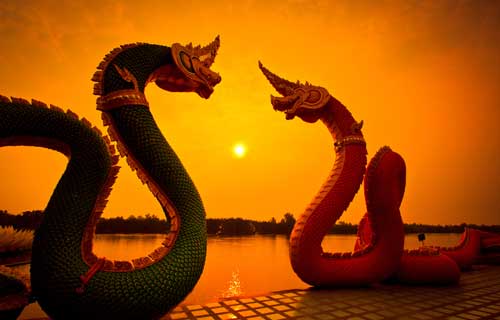
I’ve always marveled at the symbolic meaning of the uroboros (also spelled ourobouros or ouroboros) and have adopted it as a personal symbol – using it in meditations and incorporating its symbolic meaning into daily thought patterns where a shift is necessary.
I’ve written a bit on the uroboros on my symbolic Alchemy Animals page here, but was prompted to write more after seeing this post by Eksith Rodrigo who describes how to make your own Uroboros on this post.
Using his instructions, I made my own uroboros (shown above). I added a snaggle tooth & curly horns….I’ve got a thing for horns….but I digress..
The symbolic meaning of the uroboros is replete with concepts such as:
-
Cycles
-
Eternity
-
Rebirth
-
Potential
-
Perpetuity
-
Actualization
The alchemists illustrate this serpent wrapped around the cosmic egg, signifying the life span of the universe. Furthermore, the center opening shown in typical uroboros illustrations may also symbolize the egg which speaks of :
-
Inceptions
-
Beginnings
-
Openings
-
Latent power
-
Limitless potential
This opening upon which the serpent is clenched is also symbolic of the number zero and all it implies.
The serpent itself is symbolic of regeneration and the cycle of time as we observe in the shedding of a snake’s skin.
The eating of it’s own tail declares the statement “The end is the beginning” and reminds us of the eternal nature of energy which cannot be destroyed, only transformed.
I rather like the implication that only by devouring ourselves can we find our true nature. To further this point, I think of the constrictive nature of the snakes feeding pattern; its inner muscles press upon prey (in this case, itself).
This makes me think of the birthing process of diamonds. It takes a lot of pressure to make a diamond from coal. Likewise, it takes a lot of constriction for our best selves to be squeezed out of our false identities.
The uroboros makes its appearance in several cultural myths. Quickie symbolism of the uroboros in cultural myth:
-
Egyptian: Symbolic of the sun – it’s rising and setting signifying the cycle of the day
-
Gnostic: Oneness of all life, the constant process of re-recreation and the unity behind all duality
-
Roman: Eternity, time and associated with Janus the god of the new year
-
Greece: Death and rebirth as illustrated in the Orphic creation myth – another reference to the cosmic egg symbolism
-
African: Here it is known as the “rainbow serpent” or Aido Hwedo and is an emblem of sustaining life, protection and creation
The overwhelming message the uroboros provides is “all is one” – the concept of connection and the totality of all. Other thoughts that come to mind with the uroboros include:
-
Beginnings, endings, and all that’s in-betwix
-
Life, death and what we do with ourselves in between
-
Reintegration, disintegration and the phases each of these processes undergoes
No doubt, this symbol is a powerful one – we can easily see how all of its symbolic implications can reap a dramatic effect on our thoughts. I invite you to settle in with your own personal concepts of the uroboros, and see what kind of transformations come up for you!



Very nicely done!
I’m very glad you found the steps helpful.
It’s quite a unique iteration you’ve got there.
Hi Eksith, thanks again!
I really appreciate this broad explanation about snake symbolism. Very often, people assume the snake is something to fear. I frequently get inquiries about fears in areas of dream analysis. People may get stuck in the presumed sins of the Garden of Eden, danger, warning of poison and other undesirables. Whereas, reality is the snake is also a powerful positive symbol with much potential. It depends on your choice and view.
Hi Liara,
I understand where you’re coming from.
Communicating with people about their beliefs (particularly fear based) can be a slippery prospect.
I admire your work because you offer the path to higher ground to your readers.
Thanks for the comment.
Wonderful post. The mythic image of the tail devouring serpent plays a prominent role on my spirituality. Upon my Altar I have a circler necklace representing the ouroboros.
My own personal understanding of the Ouroboros is that is an image of cyclic time, associated with the cycle of the moon and cosmic cycles.
If I may quote something from my own site.
Another interesting use of the Ouroboros concerns the ‘World Soul.’.
Hi Mahud!
You are always welcome here, and I’m grateful for the input you’ve provided from your own blog.
Your insights & connections are remarkable.
Thanks for adding another intricate layer to this topic!
The Ouroboros is a very ancient symbol. Volume Two of the book titled, The Ark of Millions of Years authors E. J. Clark and B. Alexander Agnew, has an ouroboros pictured on the front cover. The authors link this symbol to the Mayan end time date of Dec. 21, 2012. This book is a fascinating, yet prophetic scarey read. I’m looking forward to their third book on 2012 which I understand will soon be out.
I’ve had a few friends tell me of this book with similar reactions.
Thank you for the added reference & insight!
Lightness,
A.
Thank you for your web site. I too have always been fascinated by symbols and try to be open to them where & when ever they appear in my life. The Oroboros is my personal symbol of that path of Self discovery. She either takes the form of a dragon or of a figure-eight snake, first creating and then consuming the darkness, thus transforming it into light. Similar to a yin/yang, but not so philosophical. Much grittier, because animal survival is at stake (to eat AND to be eaten). At one instant a base process and a divine mystery (holy communion). Through lead continually transforming into gold, the dragon yields the pearl of infinite wisdom (the true philosopher’s stone).
I watched one of your videos, and have read some of your site. I admire how honest you are about your past struggle with addiction, and that you won’t interpret symbols for others. In so doing you are both wise and strong.
You are a gifted teacher. I wish you all the best.
Hi Dave. Brilliant. Thank you for allowing us all a view into your magnificent realms of understanding. Really value what you’ve expressed here, and share similar meta-phenomenon. Thanks again for sharing your soul-bright observations!
Excellent post, however what ponders my mind is this symbol really Lucifer or Satan himself. Not anything horrific in mind but more rather spiritual; just because of the mainstream Christians have scrutinized the true interpretation meanings of spirituality. Have you ever read the “The Truth Book” particularly “Caligastia” truly this book is enlightening. It’s the truth about the bible itself plus more in depth. Thx